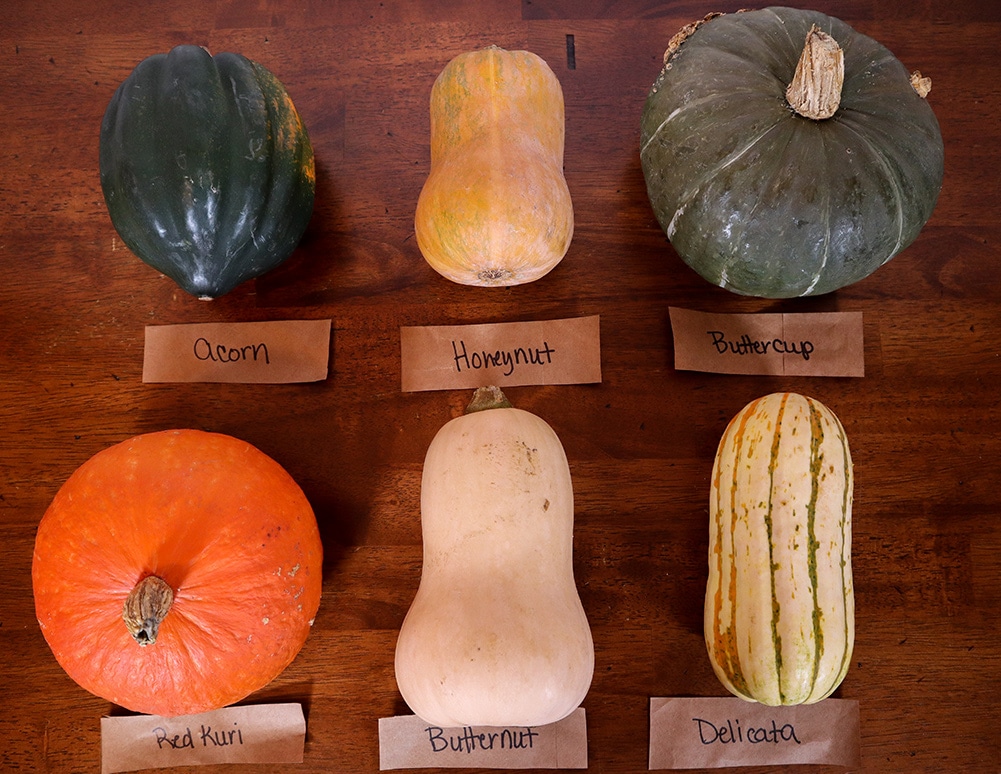
I always find it fun to wander around a farm stand in the fall and explore the many different varieties of winter squash that are harvested. There are so many exciting shapes, sizes, and colors. I want to take them all home with me! This year, I did.
I chose 6 varieties of winter squash to cut, clean, and cook to find out how each type tasted. I compared color, flavor, and texture. There were plenty of differences among these squash which surprised me! Though maybe I shouldn’t have been surprised because their outsides were all so unique.
Quick Links
The Process
General Findings
Red Kuri Squash
Honeynut Squash
Delicata Squash
Buttercup Squash
Acorn Squash
Butternut Squash
Winter Squash Ranked
Winter Squash Recipes
The Process
I cut each squash in half and cleaned out the guts and seeds. Then, I peeled half of each squash and cut the peeled half into chunks. The other half got sliced into thin wedges without peeling to help me judge how edible the peels would be.
For cooking, I placed the squash on a parchment paper lined baking sheet. I brushed the paper with olive oil and sprinkled it with salt so the bottom of the squash would be oiled and seasoned. After placing the squash on the baking sheet, I came back through with a drizzle over the top of the squash and a heavy sprinkling of salt across the tops. This made it efficient and easy to season and oil both sides of the squash.
I roasted each squash at 375F degrees for 30-45 minutes until the squash was cooked through and slightly caramelized. I flipped the squash at least once during cooking.
General Findings
Cutting & Peeling Winter Squash
I found that a trick for cutting through tough squash was to use my chef’s knife to cut halfway through; then I used a heavy serrated bread knife to saw through the rest of the squash. Only the acorn squash gave me trouble and I had to use my chef’s knife plus some force by hitting the bottom of the squash on the cutting board until the knife got through.
Peeling the squash was easier after I cut each fruit in half and gutted them. I used the empty seed cavity to help me grasp the squash while using my peeler. Again, the only variety that gave me an issue was the acorn squash because it has such deep grooves so that it was difficult to get the squash peeled. It was actually a pain, very frustrating, and I hated peeling the acorn squash. Otherwise, the rest of the squash were easy to peel.
Roasting Winter Squash
Roasting the squash at a low-ish temperature (relative to other roasting temps) allowed the squash to cook through before caramelizing. I found that 375F degrees for about 30-45 minutes worked well. This ensured the final product was tender before it browned too heavily (i.e., you’re not going to burn it this way!) Check the squash every 15 minutes and give it a stir or flip. Once the squash is a little caramelized, brown, and fork tender, you’re squash will be cooked!
Most of the peels were fairly edible, at least as long as the pieces of squash were well roasted. The only two squash where the peels seemed very tough and inedible where the acorn squash and the butternut squash.
Winter Squash Round-up & Taste Test
Red Kuri Squash
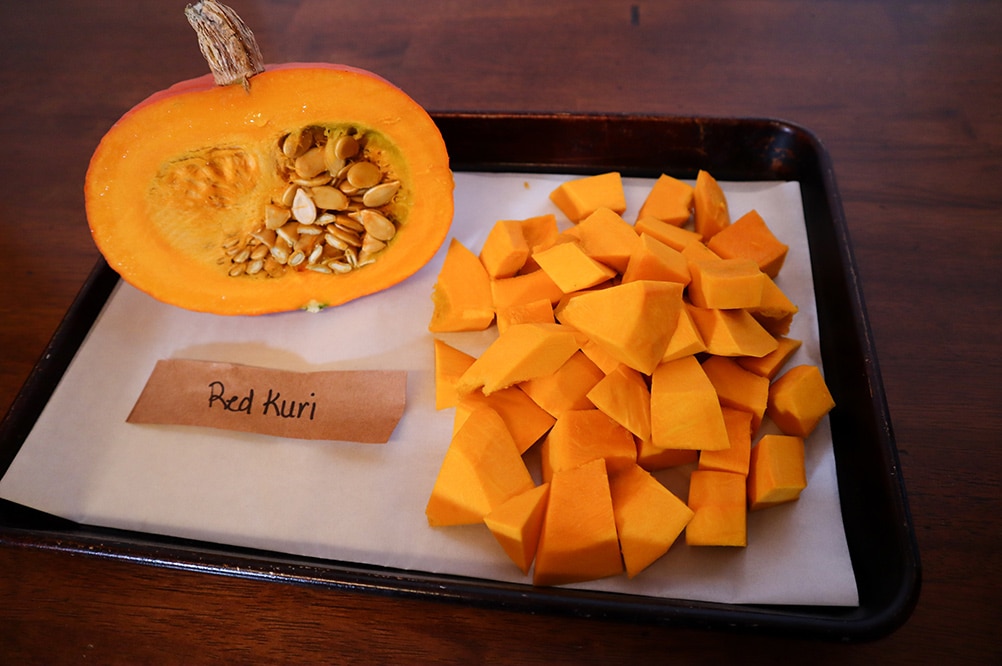
The red kuri squash was an exciting purchase. It looked like a tiny pumpkin; I loved it’s orange coloring! The name was appealing, too. The raw squash flesh was bright orange in color with really fat seeds. It was quite firm and hard to cut (until I figured out my serrated knife as a saw hack.) The skin was surprisingly quite thin. There was a large cavity once I cleaned out the seeds and guts.
Overall, despite the enjoyment I got from purchasing this cutie, it was my least favorite squash of the bunch due to it’s dryness and starchiness.
Red Kuri Squash Information
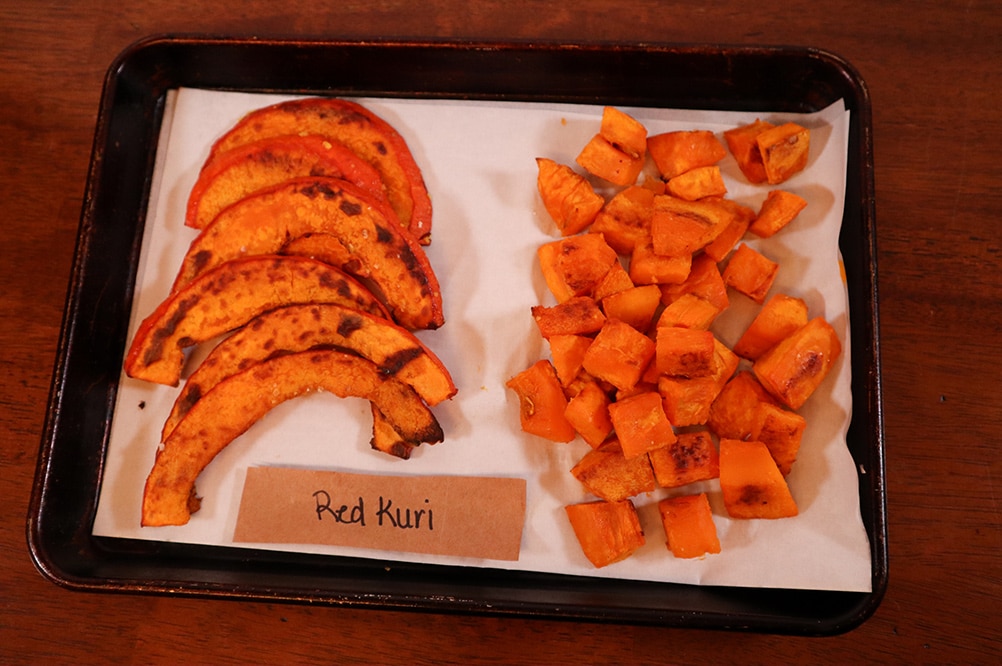
Texture: Smooth texture, but very dry despite oiling it well for roasting. Reminiscent of a potato or unripe plantain.
Sweetness: No detectible sweetness and was mostly starchy.
Skin: The skin was very thin and edible.
Cooking with red kuri squash:
- Good for moist cooking techniques like stews, curries, and soups where you would add it it in chunks like a potato.
- Mash it with butter, cream, and a little sweetener like you might for a sweet potato.
- Stuff it! The large empty cavity, and the fact that you can eat the skin, makes this a good candidate for stuffing. A moist stuffing mixture would be best to offset the dry texture of this squash. It is a beautiful squash and would make a great presentation this way.
Honeynut Squash
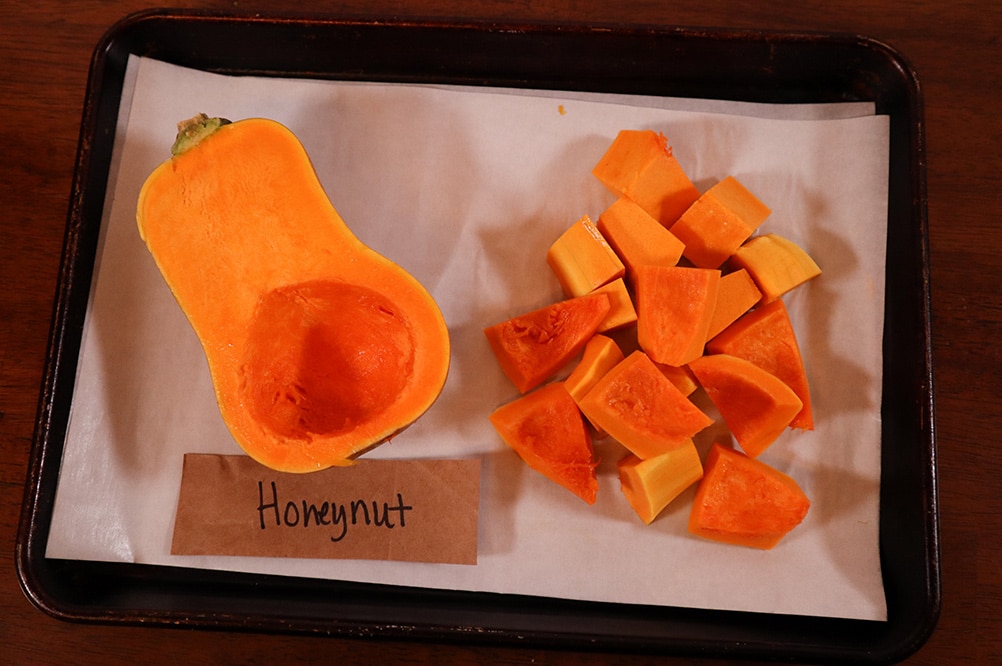
The honeynut squash is an adorable squash that looked like the child of a butternut squash. It’s coloring was a bit deeper than a butternut squash though. Due to it’s size, it had only a small amount of seeds and guts and was super easy to cut, peel, and clean. The color was a deep orange and very pretty.
This was the overall winner of the bunch between two voters (me and Sean!) It had a great texture and sweetness.
Honeynut Squash Information
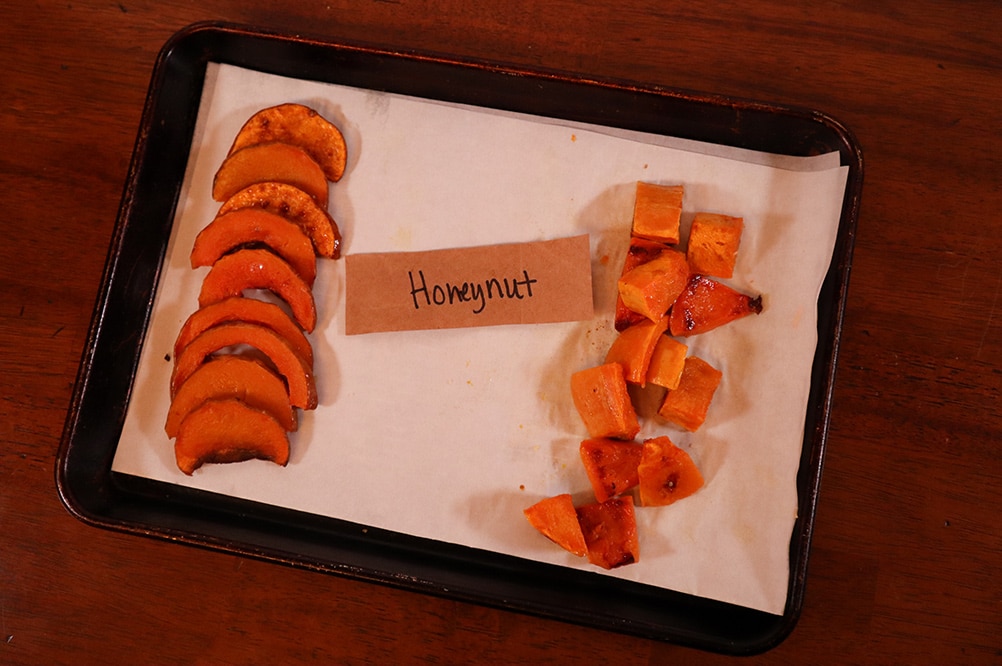
Texture: Slightly pulpy texture. Moist flesh once cooked but still able to keep it’s shape.
Sweetness: The sweetest of the bunch!
Skin: The skin was thin enough and I found it edible, but it was noticeable. It might not be for everyone.
Cooking with honeynut squash:
- This squash was so tasty and sweet, that simply roasting with a bit of salt and olive oil is a great way to enjoy it. Up the ante with a bit of sweetener, like brown sugar or maple syrup, during roasting .
- Make soup! I think this winter squash variety would be great for a traditional, seasonal creamy squash soup given it’s overall texture and flavor.
- Puree it into a sauce. Since the flavor is so nice, it would lend itself to creating a sauce for pasta.
Delicata Squash
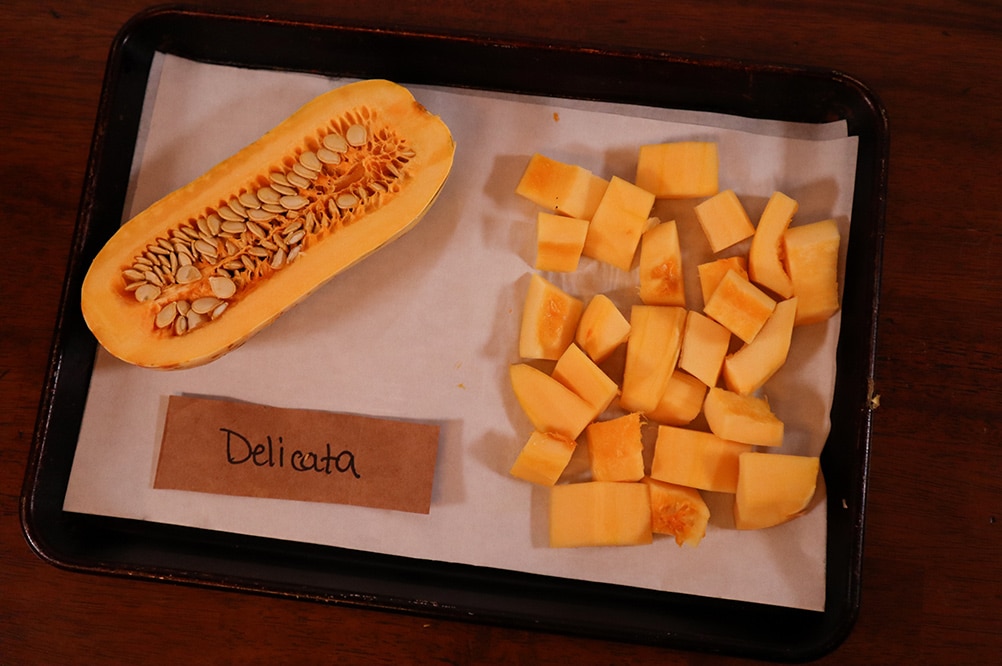
The capsule shaped delicata squash is a lovely pale yellow color with dark colored stripes. It’s oblong in shape, reasonably sized, and easy to cut. Inside is a very large cavity of seeds and guts and the shape lends itself to roasting whole or in slices. The color is yellow orange.
The overall flavor and texture of the delicata squash was pleasant. I liked snacking on this one quite a bit during this taste test.
Delicata Squash Information
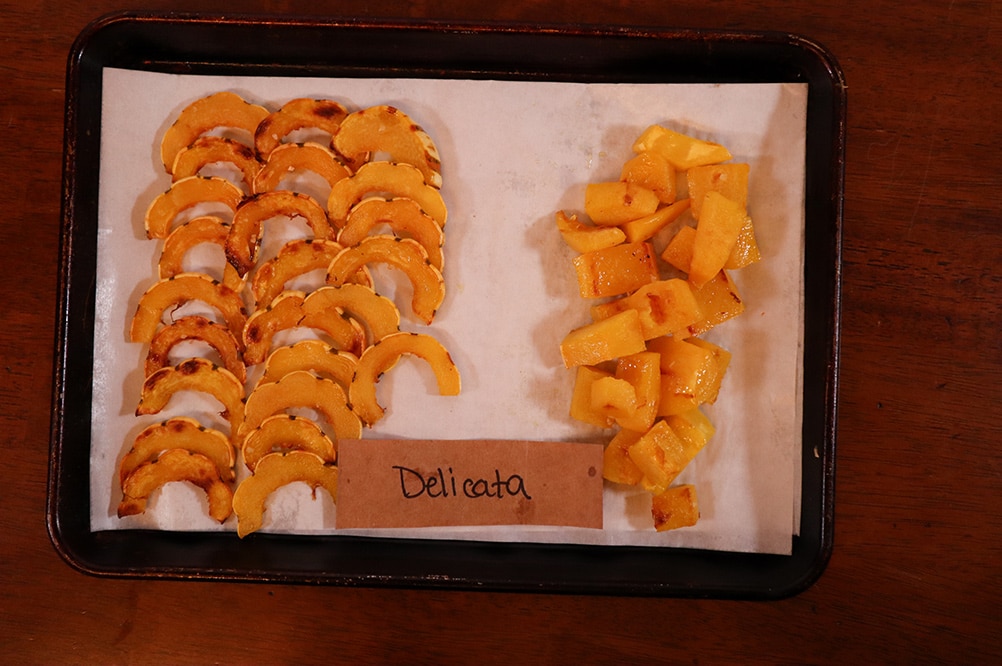
Texture: Stringy, pulpy texture. Moist flesh once cooked but still able to keep it’s shape.
Sweetness: Moderately sweet and starchy.
Skin: The skin is edible. I sliced mine thin which made the skin nice and crispy and almost like a potato chip.
Cooking with delicata squash:
- Simply roasting this squash was delicious. Thinly sliced, the crispy edges made this very snackable. Adding a bit of sweetener to the seasoning before roasting would bring out the sweet notes in the squash.
- This squash held it’s shape well and would be excellent in a room temperature salad with a seasonally flavored vinaigrette and garnishes (think dried cranberries and pepitas!)
- Stuff it! The large cavities and edible skin make this another excellent stuffing squash.
Buttercup Squash
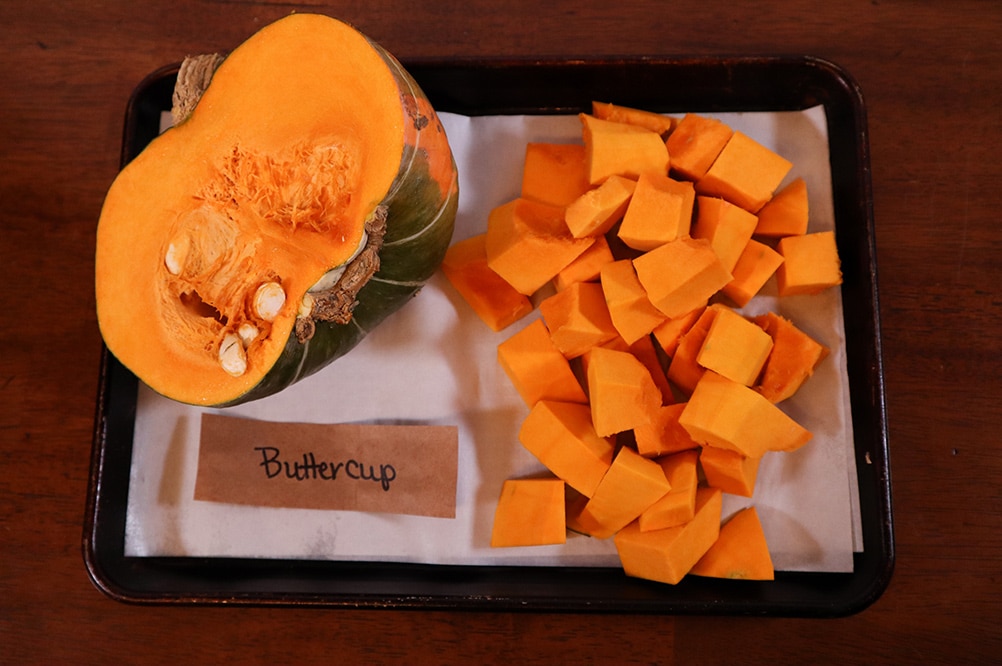
I was drawn to the name of this one. I also liked that it looked like a small green pumpkin. It was fairly easy to open and did have quite a bit of seeds and guts. The seeds were very large and thick.
My buttercup squash had “warts” which actually came off fairly easily with the peeler. This squash had an extremely vegetal smell when raw (and taste when cooked.)
Buttercup Squash Information
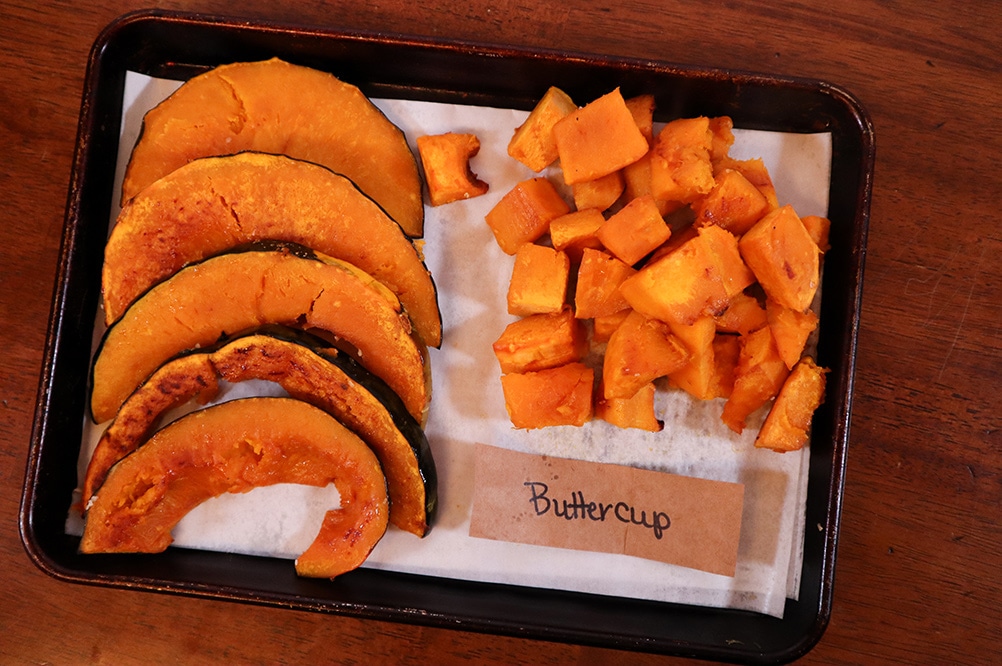
Texture: Extremely soft and buttery. Very moist. No stringiness to it at all. It did not hold it’s shape after roasting.
Sweetness: Virtually no sweetness. This squash had a very vegetal taste.
Skin: The skin was fairly thick and noticeable, but it was also edible. This is another instance where the skin likely needs to be very thin and cooked well to make it edible. It won’t be everyone’s cup of tea.
Cooking with buttercup squash:
- Make it into a soup. This would be good paired with a sweeter variety to make a traditional, creamy winter squash soup. It would add a super velvety texture while another squash, say a honeynut, could add a sweeter flavor.
- Puree it. This would be a good squash to puree or mash. Add some warm spices, sweetener, and butter for a fairly simple, classic fall side dish.
Acorn Squash
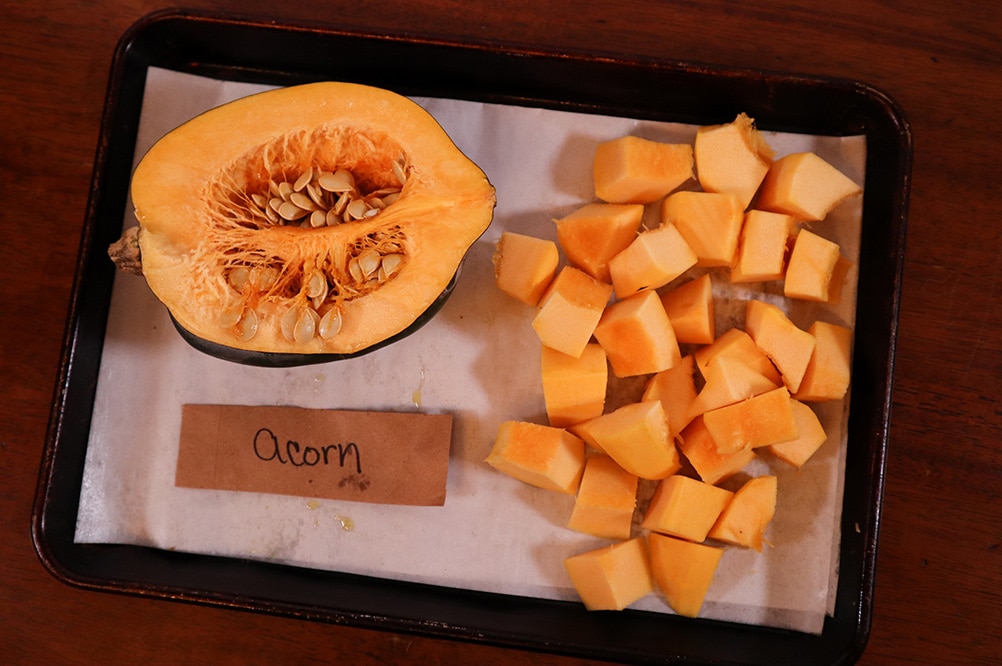
I’m pretty familiar with acorn squash and have had it several times, usually stuffed. The acorn squash was the firmest of the bunch and gave me the most trouble processing it. It was extremely difficult to cut through. And peeling almost made me want to throw my peeler across the room.
The inside of the acorn squash reveals a large cavity of seeds and guts and a pale yellow orange flesh.
Acorn Squash Information
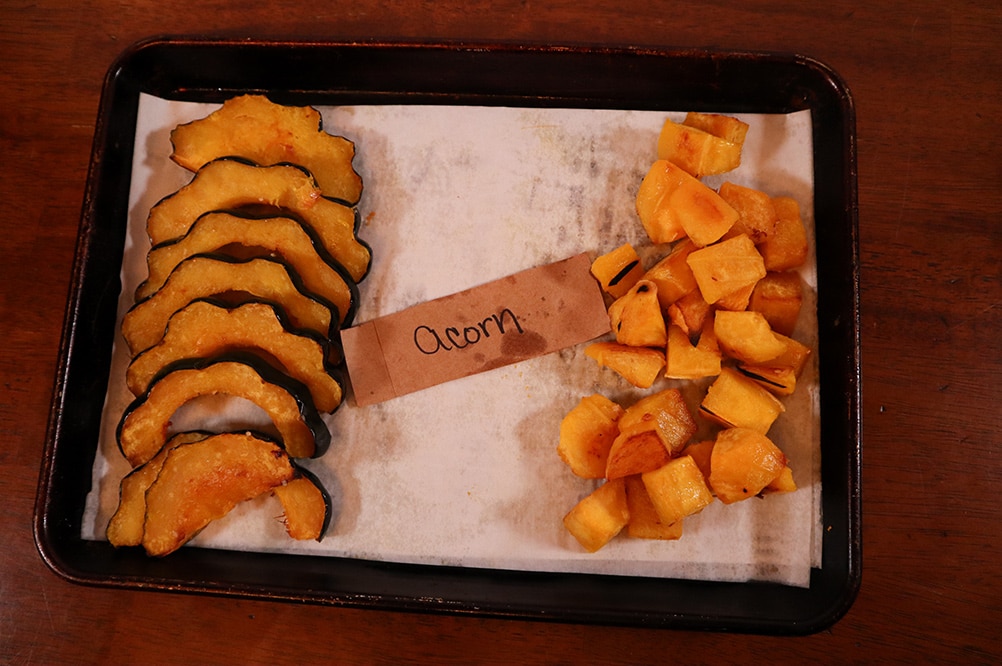
Texture: Slightly stringy/pulpy though still moist.
Sweetness: Moderately sweet. I was also surprised that this squash has a very clear acidic flavor note; one that Sean also picked up on!
Skin: It was not pleasant to eat this skin.
Cooking with acorn squash:
- Stuff it! This is a classic preparation of acorn squash for a reason. Those large cavities give plenty of room for delicious stuffing. Plus it gets you out of peeling the darn thing! Though, it’s unlikely anyone will want to eat the tough skin.
- Roast it. This variety ranks high on my list for overall enjoyment and lends itself to a simply cooking method. It’s well balanced with a great flavor and texture.
- Add it to a salad. Since this squash is fairly firm even after cooking, it would hold up well in a salad after it’s cooked and cooled.
Butternut Squash
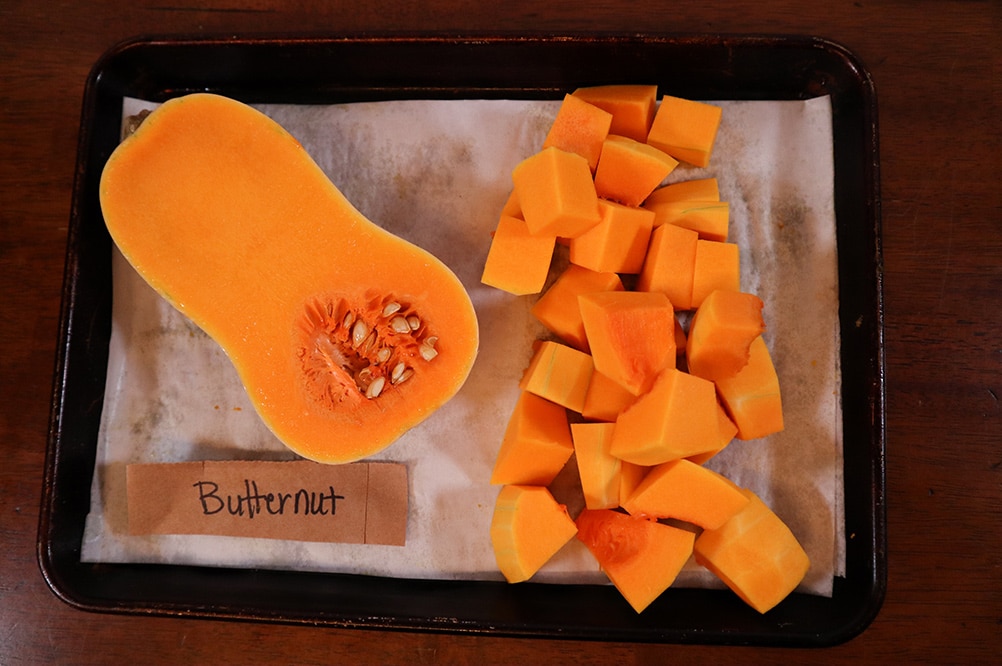
I’ve known butternut squash all of my life. It was always a centerpiece on the Thanksgiving table growing up (my grandmother served it cooked and mashed with plenty of salt, pepper, and butter.) This is the squash I’ve cooked most often. It’s easy to find and works well in many applications.
The butternut squash is similar to the honeynut squash, but larger in stature and slightly blander in flavor. It’s got a great bright orange flesh and only a small amount of waste (seeds and guts.) It’s easy to cut and peel.
Butternut Squash Information
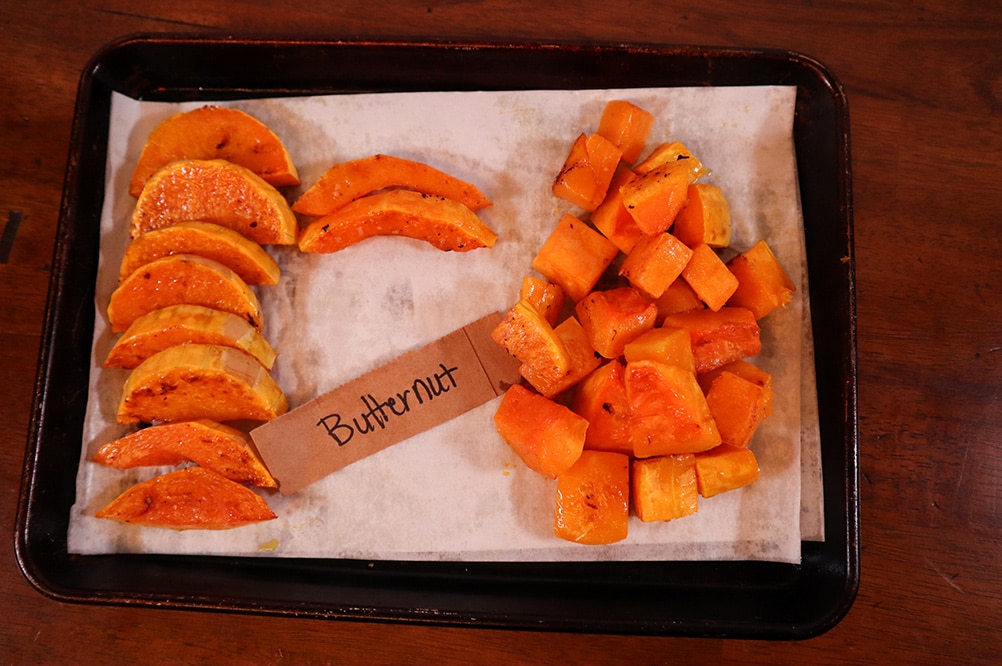
Texture: Moderately moist with a slight pulpy texture.
Sweetness: Slightly starchy and slightly sweet. More neutral in flavor than the honeynut.
Skin: It was not pleasant to eat this skin.
Cooking with butternut squash:
- Roast it. Butternut squash holds it shape well and will hold up to roasting. I’d add a bit of sweetness during the roasting session to bring out more sweetness.
- Add it to soup. While I think that the honeynut squash would make a better overall classic winter squash soup, butternut squash would do fine. Again, it will require a bit more seasoning and sweetener to bring out some flavor.
- Mash it. This is a classic preparation and one that I know many people hold dear. So, while it’s not my personal favorite, go for it!
- Add it to salads. Again, because it holds it shape well after cooking, this is a good squash to toss into a salad.
Winter Squash Ranked
After tasting each of these squash, here are my favorites from favorite to least favorite.
- Honeynut Squash: The sweetness and flavor made this a clear winner.
- Delicata Squash: This is actually tied with acorn squash and both are similar in texture and flavor which is why they are ranked at the top.
- Acorn Squash: Acorn squash is number three simply because it’s such a pain to peel. The flavor and texture are fantastic.
- Butternut Squash: Butternut squash is an old reliable. It’s easy to process, has a good yield, and is adaptable to many types of cooking.
- Buttercup Squash: I didn’t love the vegetal nature of this squash, but the buttery, velvety texture is intriguing and I think it would play well with a second squash in soup. Or work well as a sauce.
- Red Kuri Squash: I just couldn’t get over the very dry texture of this squash. It’s not bad, but certainly the bottom of this bunch.
Winter Squash Recipes
Here are a few recipes to get you started!
Red Curry Kabocha Squash Soup with Shrimp & Noodles from Cook with Kerry
I’m still building my arsenal of squash recipes, but this is one of my favorites. Try this with butternut squash, honeynut squash, or red kuri squash.
Sweet Potato & Black Bean Quesadillas from Cook with Kerry
Red kuri would be great in these quesadillas as would almost any of the squash from this story except for buttercup which I think would be too soft here.
Alton calls for butternut, but I’d challenge you to use a combination of buttercup and honeynut.
Roasted Acorn and Delicata Squash Salad from Epicurious
This one uses BOTH squashes that I think would be best for a salad. I might be tempted to add some dried cranberries to this one.
Pasta with Butternut Squash Parmesan Sauce from Simply Recipes
This looks like a simple, straight forward, and creamy pasta sauce recipe. Use butternut squash here–or change it up and give buttercup squash or honeynut squash a try.
Chipotle Mashed Sweet Potatoes from Ina Garten
Give Ina’s recipe a twist by using red kuri squash instead of sweet potatoes. I’m sure she won’t mind!
Vegetarian Stuffed Acorn Squash from Cookie & Kate
Here’s a veggie recipe that looks great with tons of texture and flavors. Try this with acorn squash, as suggested here, or give red kuri or delicata a shot.

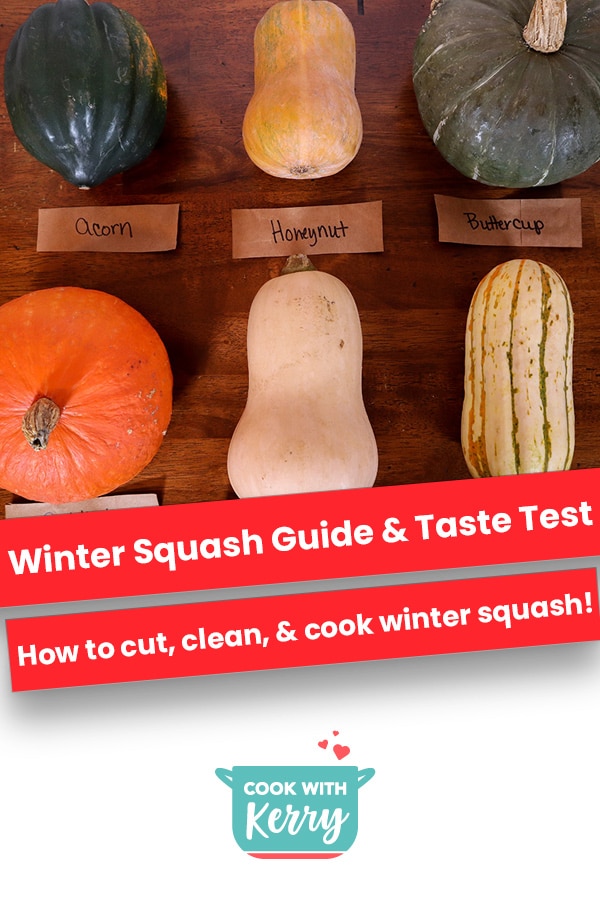
 Cauliflower Chowder
Cauliflower Chowder
Love this article! My mom grew all of these varieties this year so I’m looking forward to using your recommendations in how I prepare them.
I appreciate the sections with photos of before and after prep. It satisfies the scientific, categorizing part of my brain. Yay, squash!
I’m so happy you liked it! And I was trying very hard to go for a scientific approach here, so I’m glad it came through. I have a lot of new ideas now for squash and a fridge full so hopefully I’ll have some more squash recipes over the next few weeks. 🙂
Very well written and thorough. I agree with your descriptions of what I have had before. I gotta find the honeynut squash. Thank you
Thank you so much! Come to think about it, I need to get on that honeynut squash this season!
Great article learned a lot and will be more informed at my next trip to the farmers market! And I see many more of your articles that I will love to read. My one question: are winter squash like summer squash that the larger they are the larger the seeds? So should you select smaller winter squash to minimize the amount of seeds or is it dependent on the type of squash?
Hi. Thank you so much! And yes, this has been my experience that larger squash have larger seeds which probably doesn’t matter as much since you don’t eat the seeds. Though, I also wonder if smaller squash of the same variety taste better/are more flavorful. I’m not sure about that!
Thank you for the information about the different varieties of squash and how you prepared them.
We grew some squash this year, some spaghetti squash and yellow squash. We also had another squash, several of them, but we don’t know what it is. I’m going to cook one like you processed yours and see what we have, then pick among your results for the suggestions.
We first thought we were growing Picklesimer watermelons, but the flesh wasn’t right. The later ones turned orange like a pumpkin.
Thanks! I love squash so much and this was a fun test!
I am 80 yo and find it easier and faster to microwave the whole squash (knock the stem off first) until it is just soft enough to cut and finish in the oven. Buttercup is my favorite but I will eat any variety. Interesting article. Thank you.
I love your microwave trick. I’ll have to give that a try this fall!
Hey Kerry! Was looking for different sweetness of squashes. Ran across your article. Just a heads up in the Red Kuri, it probably needs to be cooked much longer to remove the starchiness. I’ve had it several times in the past and pressure cooked it in the Instant Pot until it was soft mush. It was the sweetest squash I’ve ever tasted!!… So I wonder if cook times would affect the taste on all your squashes. CHeers!
That’s a really good point! Now I need to try the Red Kuri in the IP. That sounds very nice!